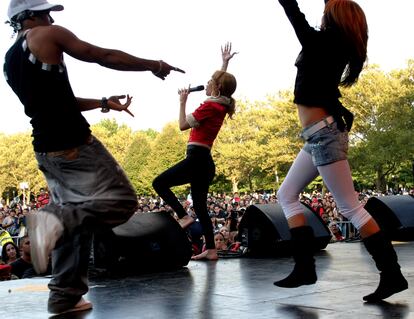From Bayamón to the Carolinas and back: Reggaeton’s journey is not over yet
Reggaeton has been the world’s most popular music genre for more than 20 years. Even though some say the genre is being diluted, its heart and soul remain pure thanks to the diversity and creativity of the musicians


Nobody really thought that reggaeton would become so popular outside of Latin America and some large Latino communities in the United States. Although some purists and experts still bestow the crown of popularity on rock or pop music, reggaeton’s vantage point as a cultural identifier and conduit to consumers enables it to embrace a variety of subject matter, subgenres and artists that appear incongruous at first glance.
Slammed, criticized and scorned with surprising vehemence, reggaeton has been able to resist, repel, absorb and decode the world with its easygoing flair. It may at times seem inappropriate and cynical, but reggaeton always infuses the right amount of wit that’s firmly rooted in the spirit of the day. It is a timely expression of our contradictory human nature and the contemporary world.
Now viewed as a commonplace artifice for a sexual and provocative ethos, reggaeton is also a sociocultural validation that traverses socioeconomic classes and world views. Ultimately, it’s a way to enjoy our most immediate reality through dance, rhythm and the physical body. Not convinced? Just ask top reggaeton artists like Bad Bunny, Natti Natasha, Karol G, J Balvin and Ñengo Flow.
The musical heart of reggaeton is, among many other things, a rich and diverse musical journey of influences and inputs from Panama, Puerto Rico and North Carolina. Digging deeper into the music’s origins takes us to Jamaica, and ultimately to Africa during the early days of the slave trade.
Tribal sounds and African polyrhythms emerge frequently in this contemporary perreo dance music, sometimes labeled as “urban music” or whatever the latest pop marketing gimmick happens to be. Reggaeton’s many roots can be traced to salsa, Cuban son music, Caribbean merengue, Puerto Rican plena and bomba, Dominican bachata, boleros, ballads and more.
In his book Reggaeton (Duke University, 2009), ethnomusicologist Wayne Marshall acknowledges the importance of the arrival and evolution of 1980s Jamaican dancehall music in countries like Panama and Puerto Rico. Yet he argues that the African veins in early Dominican dembow music best explain the flexibility and power that leads to the diversity represented by feminist, Christian, rock and conceptual reggaeton.

A clear example of the genre’s musical and historical evolution is “Gasolina” by Daddy Yankee, a favorite reggaeton anthem, which condenses all these musical roots into a sound that evokes the drumbeats of war.
Wayne Marshall says that “Gasolina” is like a tribal African call to arms with its repetition and foreboding warnings about the enemy: “Rev the engines and get ready! Get ready for what’s coming and strike! Strike hard!.” This line is reminiscent of Moroccan, Libyan and Egyptian strife, but also of Puerto Rico’s first autochthonous music – bomba. Dating back more than 400 years to the African slaves brought to work on the island’s sugar plantations, bomba rhythms like sicá steps (walking), cuembé (flirtatious and sensual rhythm danced in pairs), and the seis corrido (rapid pace) have produced a deep-rooted cultural pride.
It’s no coincidence that some reggaeton songs sound slightly arabesque and that the “flow” of artists like Don Omar and Tego Calderon elicit the rituals of Yoruba Santeria and American rap. If anything can explain the success of reggaeton, it’s this stylistic incorporation of diverse musical traditions that makes it easy for so many people to enjoy.
Panamanian DJ, producer Youtuber Rodney Sebastian Clark Donalds, alias “El Chombo,” known for major reggaeton hits like “Chacarrón” and “El Gato Volador,” claims that reggaeton as we knew it ceased to exist some time ago thanks to artists like Maluma, Thalía and even Bad Bunny. But reggaeton continues to conquer the world.
Sobre la firma
